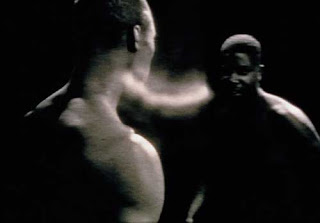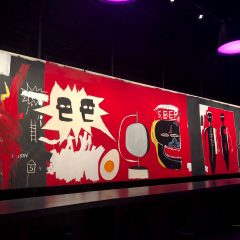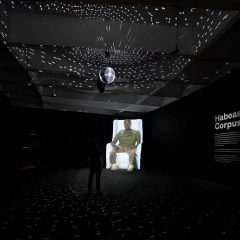
Anthony McCall Line Describing a Cone (1973, 16mm film) at the Whitney Museum of American Art’s exhibition, Into The Light (2001-2). Photograph © Henry Graber, 2002.
While in D.C. lobbying for arts legislation last week I had just enough extra time to catch an exhibition at the Hirshhorn Museum and Sculpture Garden. The Cinema Effect explores the way movies have influenced film and video artists. The exhibition is in two parts; the first, Dreams is up through May 11. Part two, Realisms, will be shown June 19-September 7.
Since the museum is open only during the daytime the exhibition was inevitably like a multi-feature matinee. But if film traditionally offers at least a fictional resolution, these cinema-inspired works provided an infinitely-delayed release, a sort of endless foreplay. In an inspired siting, visitors enter the exhibition through the red stage curtain of Douglas Gordon’s Off Screen (1998) to find themselves not backstage, but in a darkened labyrinth where they encounter an abbreviated version of Warhol’s Sleep (1963; 120 min. are shown here, excerpted from Warhol’s five hours) which dismantles film as narrative to transform it into a gay male gaze in extended time. Depiction of the object of desire sleeping has a long tradition in painting (from Titian through Picasso), but Warhol’s gaze, unblinkingly fixed upon the sleeping face of John Giorno, was just the first in the exhibition to upset our expectations that film will function differently than paintings.
Stan Douglas’ Overture (1986) with its endless circuit of a train passing through a series of mountain tunnels recalls the same subject in early films, but Douglas’ version severs the relationship between the sight and the accompanying narrative. Rodney Graham’s Rheinmetal/Victoria (2003) rather than dealing with the subject or medium of films is an homage to the technology of their production: a 35mm projector has escaped from the projection room to become part of an installation where it (noisily) plays a film depicting the sort of manual typewriter on which screenplays for 35mm films were produced.

Anthony McCall’s You + I, Horizontal (2005) growing from his works of the 1970s (see illustration above), creates a cone of light projected onto a wall through artificially-created fog; this creates a three-dimensional form without mass which is extended into the fourth dimension of time. Visitors who played with the light projected on the wall became moving silhouettes, and hence the subjects of the projection. Steve McQueen’s Bear (1993) is a beautiful ballet of male competition and desire, while Saskia Olde Wolbers‘s Trailer marries an improbable story out of a late-night tv mystery with the luscious visuals of a slow-motion sci-fi film.
The exhibition is arranged as a continuous display around the Hirshhorn’s circular plan with no exits midway, so I was grateful near the end to come upon the fixed viewpoints of Wolfgang Staehle’s Niagra (2004), an un-spectacular view of the waterfall (especially compared to Frederic Church’s painted version nearby at the Corcoran) and Siebren Versteeg’s Neither Here nor There (2005), where both camera and subjects are fixed and the variation over time is a product of changes in the pixillation. While the exhibition consists of interesting and varied works, they are mostly restricted in their camerawork (which certainly distinguishes them from the sophisticated camerawork of modern cinema) and too many use the device of the endless pan which produces a slight queasiness of motion-sickness. But go – just take your Dramamine – the trip is worth it!









